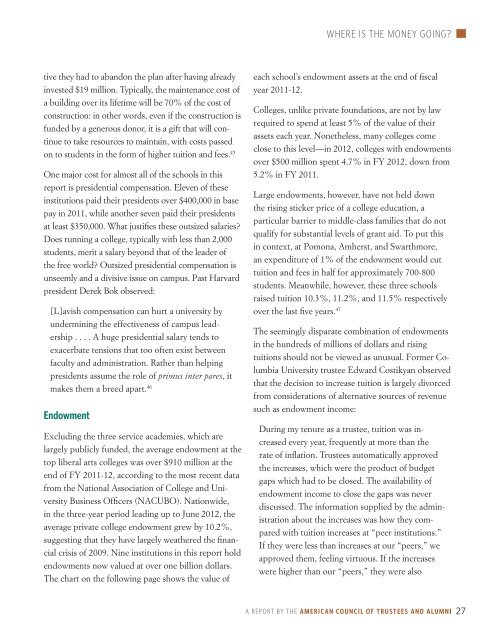k4yqkhk
k4yqkhk
k4yqkhk
You also want an ePaper? Increase the reach of your titles
YUMPU automatically turns print PDFs into web optimized ePapers that Google loves.
where is the money going?tive they had to abandon the plan after having alreadyinvested $19 million. Typically, the maintenance cost ofa building over its lifetime will be 70% of the cost ofconstruction: in other words, even if the construction isfunded by a generous donor, it is a gift that will continueto take resources to maintain, with costs passedon to students in the form of higher tuition and fees. 45One major cost for almost all of the schools in thisreport is presidential compensation. Eleven of theseinstitutions paid their presidents over $400,000 in basepay in 2011, while another seven paid their presidentsat least $350,000. What justifies these outsized salaries?Does running a college, typically with less than 2,000students, merit a salary beyond that of the leader ofthe free world? Outsized presidential compensation isunseemly and a divisive issue on campus. Past Harvardpresident Derek Bok observed:[L]avish compensation can hurt a university byundermining the effectiveness of campus leadership. . . . A huge presidential salary tends toexacerbate tensions that too often exist betweenfaculty and administration. Rather than helpingpresidents assume the role of primus inter pares, itmakes them a breed apart. 46EndowmentExcluding the three service academies, which arelargely publicly funded, the average endowment at thetop liberal arts colleges was over $910 million at theend of FY 2011-12, according to the most recent datafrom the National Association of College and UniversityBusiness Officers (NACUBO). Nationwide,in the three-year period leading up to June 2012, theaverage private college endowment grew by 10.2%,suggesting that they have largely weathered the financialcrisis of 2009. Nine institutions in this report holdendowments now valued at over one billion dollars.The chart on the following page shows the value ofeach school’s endowment assets at the end of fiscalyear 2011-12.Colleges, unlike private foundations, are not by lawrequired to spend at least 5% of the value of theirassets each year. Nonetheless, many colleges comeclose to this level—in 2012, colleges with endowmentsover $500 million spent 4.7% in FY 2012, down from5.2% in FY 2011.Large endowments, however, have not held downthe rising sticker price of a college education, aparticular barrier to middle-class families that do notqualify for substantial levels of grant aid. To put thisin context, at Pomona, Amherst, and Swarthmore,an expenditure of 1% of the endowment would cuttuition and fees in half for approximately 700-800students. Meanwhile, however, these three schoolsraised tuition 10.3%, 11.2%, and 11.5% respectivelyover the last five years. 47The seemingly disparate combination of endowmentsin the hundreds of millions of dollars and risingtuitions should not be viewed as unusual. Former ColumbiaUniversity trustee Edward Costikyan observedthat the decision to increase tuition is largely divorcedfrom considerations of alternative sources of revenuesuch as endowment income:During my tenure as a trustee, tuition was increasedevery year, frequently at more than therate of inflation. Trustees automatically approvedthe increases, which were the product of budgetgaps which had to be closed. The availability ofendowment income to close the gaps was neverdiscussed. The information supplied by the administrationabout the increases was how they comparedwith tuition increases at “peer institutions.”If they were less than increases at our “peers,” weapproved them, feeling virtuous. If the increaseswere higher than our “peers,” they were alsoA report by the american council of trustees and alumni27


